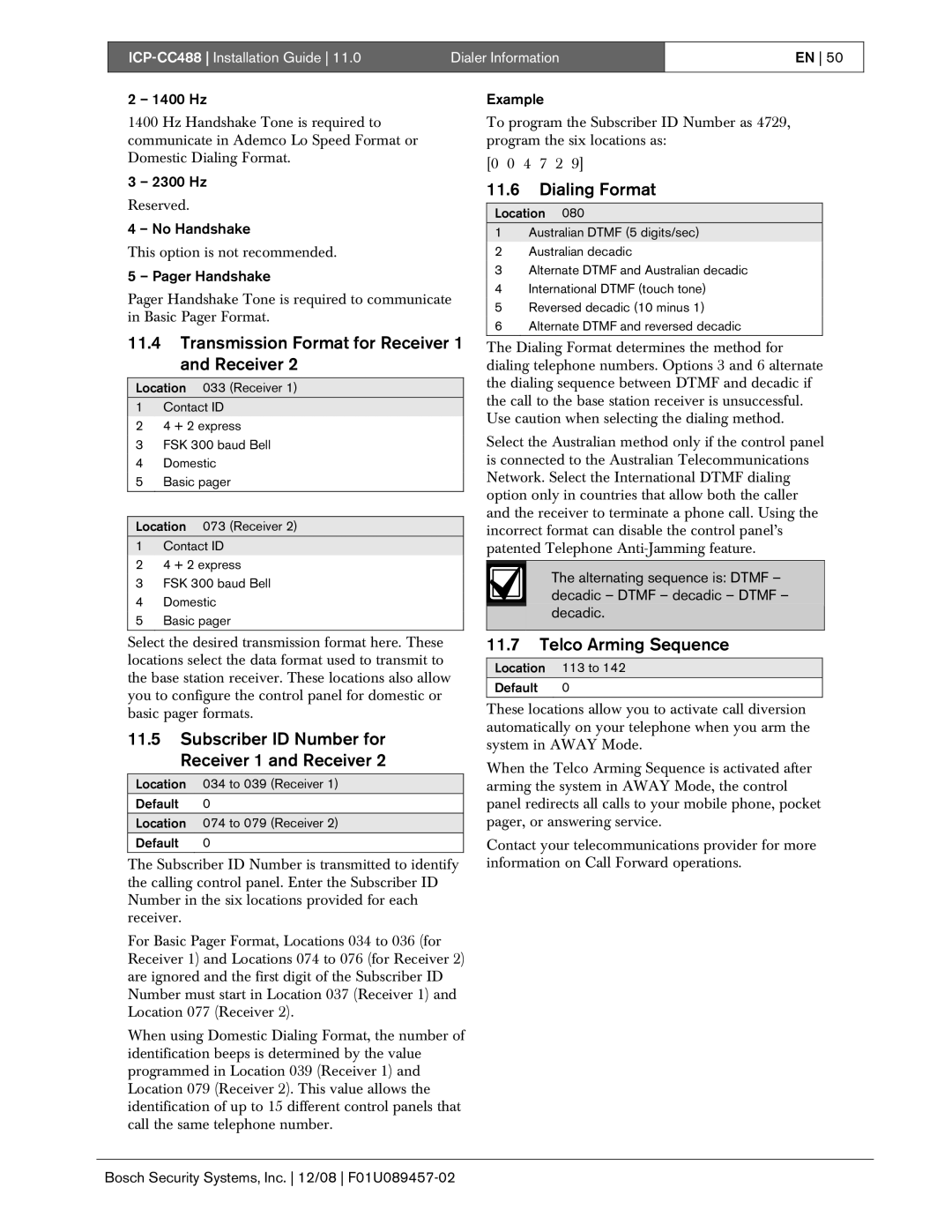
| Dialer Information |
|
|
EN 50
2 – 1400 Hz
1400 Hz Handshake Tone is required to communicate in Ademco Lo Speed Format or Domestic Dialing Format.
3 – 2300 Hz
Reserved.
4 – No Handshake
This option is not recommended.
5 – Pager Handshake
Pager Handshake Tone is required to communicate in Basic Pager Format.
11.4Transmission Format for Receiver 1 and Receiver 2
Location 033 (Receiver 1)
1Contact ID
24 + 2 express
3FSK 300 baud Bell
4 Domestic
5 Basic pager
Location 073 (Receiver 2)
1Contact ID
24 + 2 express
3FSK 300 baud Bell
4 Domestic
5 Basic pager
Select the desired transmission format here. These locations select the data format used to transmit to the base station receiver. These locations also allow you to configure the control panel for domestic or basic pager formats.
11.5Subscriber ID Number for Receiver 1 and Receiver 2
Location 034 to 039 (Receiver 1)
Default 0
Location 074 to 079 (Receiver 2)
Default 0
The Subscriber ID Number is transmitted to identify the calling control panel. Enter the Subscriber ID Number in the six locations provided for each receiver.
For Basic Pager Format, Locations 034 to 036 (for Receiver 1) and Locations 074 to 076 (for Receiver 2) are ignored and the first digit of the Subscriber ID Number must start in Location 037 (Receiver 1) and Location 077 (Receiver 2).
When using Domestic Dialing Format, the number of identification beeps is determined by the value programmed in Location 039 (Receiver 1) and Location 079 (Receiver 2). This value allows the identification of up to 15 different control panels that call the same telephone number.
Example
To program the Subscriber ID Number as 4729, program the six locations as:
[0 0 4 7 2 9]
11.6Dialing Format
Location 080
1Australian DTMF (5 digits/sec)
2 Australian decadic
3 Alternate DTMF and Australian decadic
4 International DTMF (touch tone)
5 Reversed decadic (10 minus 1)
6 Alternate DTMF and reversed decadic
The Dialing Format determines the method for dialing telephone numbers. Options 3 and 6 alternate the dialing sequence between DTMF and decadic if the call to the base station receiver is unsuccessful. Use caution when selecting the dialing method.
Select the Australian method only if the control panel is connected to the Australian Telecommunications Network. Select the International DTMF dialing option only in countries that allow both the caller and the receiver to terminate a phone call. Using the incorrect format can disable the control panel’s patented Telephone
The alternating sequence is: DTMF – decadic – DTMF – decadic – DTMF – decadic.
11.7Telco Arming Sequence
Location 113 to 142
Default 0
These locations allow you to activate call diversion automatically on your telephone when you arm the system in AWAY Mode.
When the Telco Arming Sequence is activated after arming the system in AWAY Mode, the control panel redirects all calls to your mobile phone, pocket pager, or answering service.
Contact your telecommunications provider for more information on Call Forward operations.
